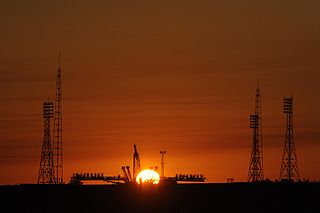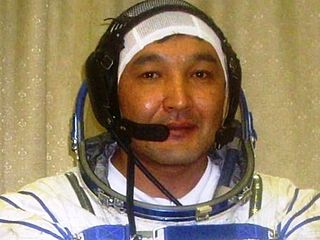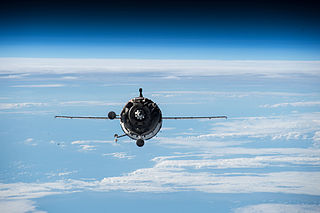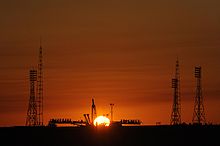
Toktar Ongarbayuly Aubakirov is a retired Kazakh Air Force officer and a former cosmonaut. He is the first person from Kazakhstan to go to space.

The Soyuz programme is a human spaceflight programme initiated by the Soviet Union in the early 1960s. The Soyuz spacecraft was originally part of a Moon landing project intended to put a Soviet cosmonaut on the Moon. It was the third Soviet human spaceflight programme after the Vostok (1961–1963) and Voskhod (1964–1965) programmes.

A spaceport or cosmodrome is a site for launching or receiving spacecraft, by analogy to a seaport for ships or an airport for aircraft. The word spaceport, and even more so cosmodrome, has traditionally been used for sites capable of launching spacecraft into orbit around Earth or on interplanetary trajectories. However, rocket launch sites for purely sub-orbital flights are sometimes called spaceports, as in recent years new and proposed sites for suborbital human flights have been frequently referred to or named "spaceports". Space stations and proposed future bases on the Moon are sometimes called spaceports, in particular if intended as a base for further journeys.

The Baikonur Cosmodrome is a spaceport operated by Russia within Kazakhstan. Located in the Kazakh city of Baikonur, it is the largest operational space launch facility in terms of area. All Russian crewed spaceflights are launched from Baikonur.

Baikonur, formerly known as Leninsk, is a city in Kazakhstan on the northern bank of the Syr Darya river. It is currently leased and administered by the Russian Federation as an enclave until 2050. It was constructed to service the Baikonur Cosmodrome and was officially renamed Baikonur by Russian president Boris Yeltsin on December 20, 1995. During the Soviet period, it was sometimes referred to as Zvezdograd (Звездоград), Russian for Star City.

Plesetsk Cosmodrome is a Russian spaceport located in Mirny, Arkhangelsk Oblast, about 800 km north of Moscow and approximately 200 km south of Arkhangelsk. Originally developed as an ICBM site for the R-7 missile, it also served for numerous satellite launches using the R-7 and other rockets. Its high latitude makes it useful only for certain types of launches, especially the Molniya orbits, so for much of the site's history it functioned as a secondary location, with most orbital launches taking place from Baikonur, in the Kazakh SSR. With the end of the Soviet Union, Baikonur became a foreign territory, and Kazakhstan charged $115 million usage fees annually. Consequently, Plesetsk has seen considerably more activity since the 2000s.

Space Adventures, Inc. is an American space tourism company founded in 1998 by Eric C. Anderson. Its offerings include zero-gravity atmospheric flights, orbital spaceflights, and other spaceflight-related experiences including cosmonaut training, spacewalk training, and launch tours. Plans announced thus far include sub-orbital and lunar spaceflights, though these are not being actively pursued at present. Nine of its clients have participated in the orbital spaceflight program with Space Adventures, including one who took two separate trips to space.

Sergey Aleksandrovich Volkov is a retired Russian cosmonaut and engineer. He was a member of three missions to the International Space Station, spending more than a year in total in space. During his missions he did four spacewalks lasting more than 23 hours in total. Volkov retired from the Cosmonaut group in February 2017.

Gagarin's Start, also known as Baikonur Site 1 or Site 1/5 was a launch site at Baikonur Cosmodrome in Kazakhstan that was used for the Soviet space program and Roscosmos.

The Vostochny Cosmodrome is a Russian spaceport above the 51st parallel north in the Amur Oblast, in the Russian Far East. It is intended to reduce Russia's dependency on the Baikonur Cosmodrome in Kazakhstan. The first launch took place on 28 April 2016 at 02:01 UTC. As of 1 July 2022, eleven launch attempts have been made with ten successes.

Soyuz TMA-19 was a crewed spaceflight to the International Space Station (ISS) and is part of the Soyuz programme. It was launched on 15 June 2010 carrying three members of the Expedition 24 crew to the International Space Station, who remained aboard the station for around six months. Soyuz TMA-19 was the 106th crewed flight of a Soyuz spacecraft, since the first mission which was launched in 1967. The spacecraft remained docked to the space station for the remainder of Expedition 24, and for Expedition 25, to serve as an emergency escape vehicle. It undocked from ISS and landed in Kazakhstan on 26 November 2010. It was the 100th mission to be conducted as part of the International Space Station programme since assembly began in 1998.

Aidyn Akanuly Aimbetov is a Kazakh cosmonaut.
Mukhtar Rabatuly Aymakhanov is a Russian cosmonaut; he was originally a Kazakhstan cosmonaut.

Soyuz TMA-21 ("Gagarin") was a Soyuz flight to the International Space Station (ISS). It transported three members of the Expedition 27 crew to the ISS, and docked at the station on April 6, 2011. TMA-21 is the 109th flight of a Soyuz spacecraft, the first of which launched in 1967. The Soyuz remained attached to the space station as a lifeboat, throughout the remainder of Expedition 27 and through the end of Expedition 28, and returned to Earth on September 16, 2011.
The National Space Agency of the Republic of Kazakhstan, also known as KazCosmos, or KazKosmos, is Kazakhstan's national space agency, and was officially established on 27 March 2007.

Soyuz TMA-16M was a 2015 flight to the International Space Station. It transported three members of the Expedition 43 crew to the station. TMA-16M was the 125th flight of a Soyuz spacecraft, the first having launched in 1967.

Soyuz TMA-18M was a 2015 Soyuz spaceflight to the International Space Station. It provided the two twelve-months occupants at the International Space Station with a fresh Soyuz capsule. TMA-18M was the 127th flight of a Soyuz spacecraft; the first having occurred in 1967. The ascent flight consisted of a Russian commander and two flight engineers from Denmark (ESA) and Kazakhstan respectively. The flight launched in September 2015 and returned to Earth in March 2016.
KazSat-3 is a telecommunications satellite which was launched 28 April 2014 at 04:25:00 UTC from Cosmodrome Baikonur in Kazakhstan. with a Proton-M launch vehicle.

The International Day of Human Space Flight is the annual celebration, held on 12 April, of the anniversary of the first human space flight by Yuri Gagarin (USSR). It was proclaimed at the 65th session of the United Nations General Assembly on 7 April 2011, a few days before the 50th anniversary of the flight.

Sergey Valeryevich Prokopyev is a Russian cosmonaut. On June 6, 2018, he launched on his first flight into space aboard Soyuz MS-09 and spent 197 days in space as a flight engineer on Expedition 56/57. On September 21, 2022, he launched aboard Soyuz MS-22 and returned onboard Soyuz MS-23 on September 27, 2023.
















